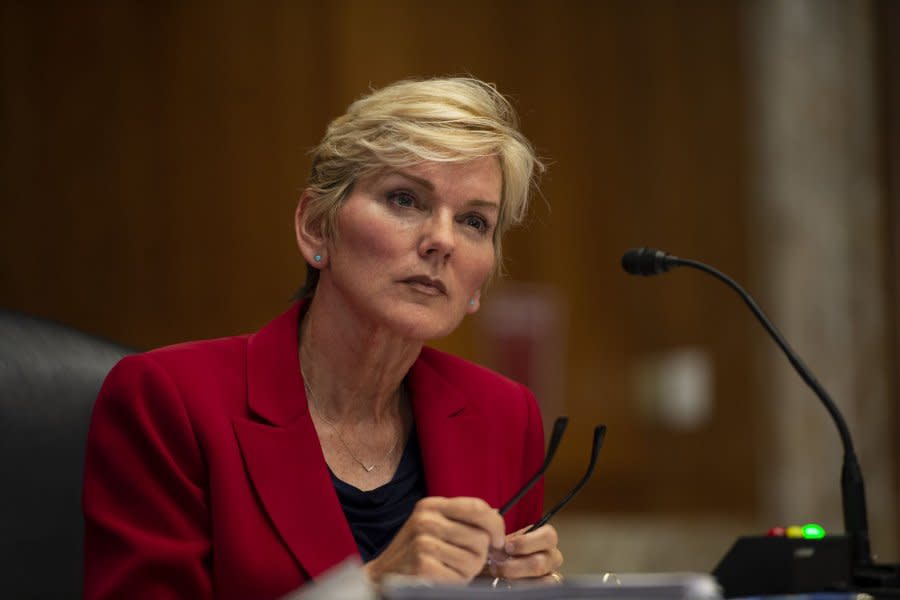SCI-FI-TEK
U.S. Energy Department announces $1.2 billion to build two carbon dioxide removal sites in Texas, Louisiana
A.L. Lee
Fri, August 11, 2023

Energy Secretary Jennifer Granholm announced funding to build two direct air capture facilities in Texas and Louisiana to help mitigate the global climate crisis. File Photo by Bonnie Cash/UPI
Aug. 11 (UPI) -- The U.S. Department of Energy will announce $1.2 billion in climate funding Friday to build two commercial-scale direct air capture facilities in Texas and Louisiana that will help reduce the concentration of carbon dioxide in the atmosphere.
The initiative is being funded through President Joe Biden's Bipartisan Infrastructure Law and is part of the Regional Direct Air Capture Hubs program, which aims to build a national network of carbon removal sites to mitigate the escalating climate crisis.
The funding for the project stands to become the world's largest-ever investment in engineered carbon removal, with each new hub capable of clearing more than 250 times more carbon dioxide from the air than the largest capture facility in operation today, the Energy Department said in a statement.
The goal of direct air capture is twofold -- to remove perpetual carbon dioxide pollution from the atmosphere and extract the everyday emissions from human activities like transportation, industry, manufacturing and waste management, as well as the CO2 produced by wildfires.
"Cutting back on our carbon emissions alone won't reverse the growing impacts of climate change; we also need to remove the CO2 that we've already put in the atmosphere -- which nearly every climate model makes clear is essential to achieving a net-zero global economy by 2050," said Energy Secretary Jennifer Granholm.
In total, the new facilities are expected to rid the air of more than 2 million metric tons of CO2 emissions each year -- which is equal to the amount of contaminants put out by 445,00 gas-powered vehicles, the agency said.
Biden's net-zero emissions plan, however, is far more ambitious -- calling for between 400 million and 1.8 billion metric tons of CO2 to be removed from the atmosphere and captured from emissions sources annually by 2050.
The rising hubs in Calcasieu Parish, La., and Kleberg County, Texas, will kickstart the effort while fostering labor and community growth as the administration seeks increased solutions to extreme weather events that continue to rack the country each year due to climate change.
"Their development will help inform future public and private sector investments and jumpstart a new industry critical to addressing the climate crisis on a global scale," the Energy Department stated. "DOE is dedicated to ensuring that the selected Regional DAC Hubs projects deliver community benefits and avoid harm in those communities while also advancing the development of carbon capture, transport, and storage systems."
The direct air capture process separates carbon from oxygen, and thus reduces CO2 in the atmosphere. The trapped CO2 can then be safely stored underground or converted into useful carbon products like concrete, which would prevent its release back into the air.
Carbon dioxide removal technology is critical to curtailing climate change and could help the United States become more competitive in the global economy of the future, the agency said.
The construction and ongoing maintenance of the facilities will create nearly 5,000 new jobs in Texas and Louisiana, the agency said.
A recent report from the U.N.'s Intergovernmental Panel on Climate Change blamed carbon dioxide pollution for warming the planet and its oceans continuously for more than half a century while damaging public health and ecosystems worldwide.
Energy Department announces largest-ever investment in 'carbon removal'

Emissions rise from the smokestacks at the Jeffrey Energy Center coal power plant as the suns sets, near Emmett, Kan. (AP Photo/Charlie Riedel, File)
Updated Fri, August 11, 2023
The Energy Department announced Friday it is awarding up to $1.2 billion to two projects to directly remove carbon dioxide from the air in what officials are calling the largest investment in “engineered carbon removal” in history.
The process, known as direct air capture, does not yet exist on a meaningful scale and could be a game changer if it did and were economical.
“If we deploy this at scale, this technology can help us make serious headway toward our net zero emissions goals while we are still focused on deploying more clean energy at the same time,” Energy Secretary Jennifer Granholm said in a press conference call.
Project Cypress will be built in Calcasieu Parish, Louisiana. South Texas DAC is planned for Kleberg County, Texas. Each claims it will capture up to one million metric tons of carbon dioxide per year initially. A representative of the Texas project said it will scale up to remove 30 million metric tons per year once fully operational. No date was given.
Officials said the projects will create 5,000 jobs for local workers and people formerly employed in the fossil fuel industry.
Louisiana Governor John Bel Edwards, who was also on the conference call, said his state, with its experience in petrochemical manufacturing, density of pipelines and geology, is best suited for projects that tackle carbon.
The announcement shows the big bets the Biden administration is making on technologies that capture carbon dioxide from the air and store it underground to address climate change. It's this gas more than any other that is heating the planet.
Several scientists agreed with making some investment in direct air capture.
Claire Nelson, a postdoctoral research scientist at Columbia University’s Lamont-Doherty Earth Observatory said moving away from fossil fuels and producing the things we need without emissions are the most important ways to address climate change. But the scale of change needed makes direct air capture necessary as another tool. “In order to have direct air capture ready at the scale we need it by 2050, we need to invest in it today,” she said.
Tim Lieuwen, executive director of the Strategic Energy Institute at the Georgia Institute of Technology agreed that the pollution from some kinds of heavy industry will need to be addressed through technologies like direct air capture.
“We need to look at reducing emissions as quickly as practically possible,” said Melissa Lott, director of research for the Center on Global Energy Policy at Columbia University.
“This means more efficiency, more clean energy, and the use of other technologies including carbon management,” she said.
Shannon Boettcher, professor of chemistry at the University of Oregon, said direct air capture technologies are not yet cost effective, and are worth some investment in research and development.
But some others say the technology for sucking carbon dioxide out of the air is still in its infancy, funding it is misguided, and the focus should be on eliminating emissions.
“This money could be so much better spent on actual climate solutions that would be cutting emissions from the get go,” said Jonathan Foley, executive director of Project Drawdown, a group that publicizes climate solutions. He cited energy efficiency and lowering emissions from agriculture, transportation, electricity generation as better approaches.
“What worries me and a lot of other climate scientists is that it potentially creates a fig leaf for the fossil fuel industry ... the idea that we can keep burning stuff and remove it later,” Foley added.
It's still unclear what role direct air capture will play in lowering emissions. Established technologies like solar, wind, and batteries continue to grow fast.
______
Associated Press climate and environmental coverage receives support from several private foundations. See more about AP’s climate initiative here. The AP is solely responsible for all content.









